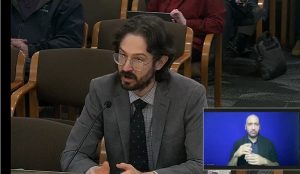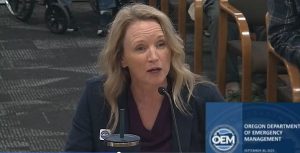Oregon Emergency Management reviews lessons learned in 2024
8 min read
Presenter: After a record wildfire year in Oregon, and after seeing the unexpected impacts of Hurricane Helene elsewhere in the nation, what lessons did we learn in 2024? At the Senate committee overseeing emergency management Dec. 10, Erin McMahon:
[00:00:15] Erin McMahon (Oregon Department of Emergency Management, director): My name, for the record, is Erin McMahon. I am the director of Oregon’s Department of Emergency Management. I’m just going to be here today to give you a brief overview of some of the things that we have accomplished with Oregon’s Department of Emergency Management over the past year.
[00:00:31] At the core of OEM’s mission, of course, is to lead those collaborative statewide efforts to help Oregonians prepare in times of crisis. By working inclusively with our partners and our communities that we serve, we aim to ensure the capabilities to protect, mitigate, prepare for, respond to, and recover from disaster.
[00:00:55] I’m going to talk about some of those individual activations briefly.
[00:00:59] First, talk a little bit about the January ice storm. Of course, you know 240,000 Oregonians lost power during that storm. The estimated cost for that damage was over $48 million. And we have been working with FEMA, who is colocated within our EOC (emergency operations center) now, and have already obligated $5.5 million to support the recovery effort.
[00:01:26] And I will tell you that that is the fastest that FEMA has seen recovery operations move. We are ahead of the schedule that we set for ourselves, and I attribute that to the close coordination that we have enjoyed with our FEMA partners.
[00:01:41] Next, the July 4th heat wave. You know, we took a lesson from what we learned during that 2021 heat dome event. And we saw a lot of our state and local agencies leaning forward to provide cooling centers and cooling resources to support our community to deal with that heat wave. Unfortunately, we did have 11 deaths attributed to that heat wave.
[00:02:07] That heat contributed to the buildup of the wildland fires that we then saw later during this summer, and it’s all part of a larger picture of some of the environmental issues that we are dealing with in this state.
[00:02:21] Presenter: Over 1.9 million acres burned in Oregon in 2024, the most ever. Erin McMahon.
[00:02:27] Erin McMahon (Oregon Department of Emergency Management, director): A lot has been made of the 2024 wildfires. You know that over 100 days we were activated to support these wildfires. We facilitated over 174 missions, 10 emergency management assistance compacts, and that’s the bringing in of other states into our state to support Oregonians during that crisis.
[00:02:51] The estimated cost: $650 million, the largest, one of the costliest disasters to date, and we continue to work with our state partners, our nonprofits, and our private organizations on the recovery from those wildland fires.
[00:03:10] We’re also working closely with OSFM (Oregon State Fire Marshal) and ODF (Oregon Department of Forestry) on the mitigation planning that we can engage in as we received over $11 million in post-fire mitigation programs. We’re working with them to identify what mitigation efforts can help us prepare for next summer.
[00:03:28] Presenter: The Emergency Coordination Center (ECC) also activated to support election integrity. Erin McMahon:
[00:03:34] Erin McMahon (Oregon Department of Emergency Management, director): The 2024 elections: This was the first time that the ECC activated in support of incident monitoring, briefings, coordinations, and logistic support to our partner agencies ahead of the elections and during that election period. This helped facilitate seamless communications with our partners we pushed out that grant funding out to those local counties to secure and safeguard our electoral process.
[00:04:03] Of course, the ECC, not activated every day, but every day we are doing search and rescue. We’re now at over 1,000 search and rescue missions across the state. That continues to be an ongoing effort, as we work closely with our sheriffs and the Civil Air Patrol to be able to provide search and rescue capability.
[00:04:25] Lessons that we have learned as a result of all of these events: obviously, that need for better integrated response and recovery efforts. We continue to learn these lessons of how we can do that better communication.
Improvements in our situational reporting during incidents: We have continued to evolve that process so that we are ensuring that we are providing helpful and useful information at the local and statewide level.
[00:04:52] We are identifying what are those upgrades to IT systems that will assist us in making that seamless communication.
We are improving communication with our local emergency managers and highlighting the challenges that they have faced at the local level and trying to elevate the voices of those local communities the best that we can.
[00:05:12] I’ve spoken to you a great deal about the work that we have done externally in support of emergency operations, but I also have to highlight the great work of our grant administrators, because they’re the ones who are working very hard to support the distribution of the funds that allow our local emergency managers and our state partners to engage in the preparedness that they need and the recovery that they need.
[00:05:38] To date, we have already distributed over $680 million. We have spent over $175 million in preparedness and mitigation grant money; 533 local preparedness and mitigation projects have been funded across the state; and $505 million in just recovery dollars so far in 2024.
[00:06:03] We assist us in preparing for the worst through our training and exercises. And to date, we have hosted over 137 trainings across the state culminating in the exercise of Cascadia IronOR 24 earlier this year.
[00:06:20] And I know that, Sen. (Chris) Gorsek, Sen. (Aaron) Woods, Sen. (James) Manning, you had an opportunity to visit and get an overview of IronOR 24. And you know that the engagement, the success of that training exercise helped us to think about and prepare for what our worst day is going to be like.
[00:06:37] And those of you who were watching your phones: You saw that threat in real time when we got the alert from the National Tsunami Warning Center about what was about to approach our coastline. Fortunately, we were spared any major impacts from that earthquake that hit California.
[00:06:55] But that was a real warning call, a real wake-up call. And it allowed us yet again another opportunity to think about: Where are we short? Where are those gaps in our preparedness? It made that whole scenario very real to those of us that were sitting in the ECC that day.
[00:07:14] Finally, I want to talk about our preparedness, the outreach efforts, and I’ve spoken to you a little bit about our Be 2 Weeks Ready program in the past. This program has been hugely successful across the state to educate our communities on what they need to do to be prepared.
[00:07:31] You know, we saw in North Carolina the impacts of Hurricane Helene and the reliance of the communities on the state to help support them immediately following the disaster. We are preparing Oregonians to take care of themselves for those two weeks. That is the message that we have in that Be 2 Weeks Ready. That allows us to prioritize the resources to those that are in most need. It allows us to direct resources to rescue people and get them out of harm’s way.
[00:08:04] So it’s causing Oregonians to think about how they can be resilient individually and as communities. And we continue to enhance and grow that program. We’ve attended multiple events across the state to facilitate and share that program.
[00:08:21] Finally, really a great program with our public and private partnership, and that allows us to engage with some of our best private partners across the state to, again, prepare for our worst day thinking about what can those private entities do to support us because they’re situated right here in the state and we can take immediate advantage of what they can offer us.
[00:08:47] Over 3,132 attendees have attended our security and resilience seminar, which has also included all 50 states, who are all checking in to what we are doing here in Oregon as part of that preparedness program.
[00:09:02] Presenter: Sen. Chris Gorseck:
[00:09:03] Sen. Chris Gorseck: The earthquake was definitely something that should give us pause. And the one thing about that, too, was that was something focused off of California, but really the entire Oregon coast was at risk to that. We’re just lucky that it didn’t cause underwater landslides, which then trigger the release of these waves.
[00:09:27] Unfortunately, I think sometimes when people hear the warnings, then nothing happens, it’s like, ‘Oh, well, what’s the problem?’ It is a serious problem. So I applaud the work that you’re doing.
[00:09:42] Presenter: Emergency Management Director Erin McMahon.
[00:09:45] Erin McMahon (Oregon Department of Emergency Management, director): Yes, thank you. It was important for us to get out external communication immediately following that event as well. A number of Oregonians did exactly what they needed to do and started to move out of harm’s way. You know, when that earthquake was first reported, it was at a 7.3 (on the Richter scale), which is statistically relevant because anything over a 7.1 is a threat for tsunami and triggers those instantaneous warnings. Over time, it was downgraded to a 7.0, which allowed them to lift that warning.
[00:10:17] But I will tell you, Sen. Gorsek, I was sitting there when we got the call and we were advised that we had about 15 minutes till first impact on the Oregonian coast. That was a very heart-wrenching moment in our ECC, I can assure you.
[00:10:32] Sen. Chris Gorseck: I’m sure.
[00:10:34] Erin McMahon (Oregon Department of Emergency Management, director): And we had some really quick lessons learned. You know, one of the things that we weren’t able to do was to see what was going on on the coast. Those cameras, those webcams were not working. I cannot tell you how frustrating that was, to try to capture what is the visual so that we could see the coastline. So we were pretty much crowdsourcing as much information as we could.
[00:10:56] That is unacceptable. We need to have eyes on. And so we are already talking to our partners and seeing how we can get eyes on the coast with that immediate initial warning so that we can monitor what’s going on on that coastline and share that information with our other state partners and our local emergency managers. So we’re already working on that.
[00:11:19] I’ve talked to you a little bit about our crisis management system, and we did receive some initial funding and the governor’s support for a future crisis management system that’s going to help us better integrate. Right now, we’ve got to track it, we’ve got to pull it up and track it, right? And organize it. We don’t have a way to do that seamlessly.
[00:11:37] I’d also like to be able to take advantage of crowdsourcing information that our citizens are collecting and to be able to pull that into our ECC as well, giving us the best situational awareness.
[00:11:49] Presenter: Oregon’s Department of Emergency Management takes a look back at 2024’s ice storm, heat wave, and record-setting wildfires. Elsewhere, Hurricane Helene and an earthquake off the California coast emphasize the importance of both individual and community preparedness. To learn more, check out the state’s Be 2 Weeks Ready program.






